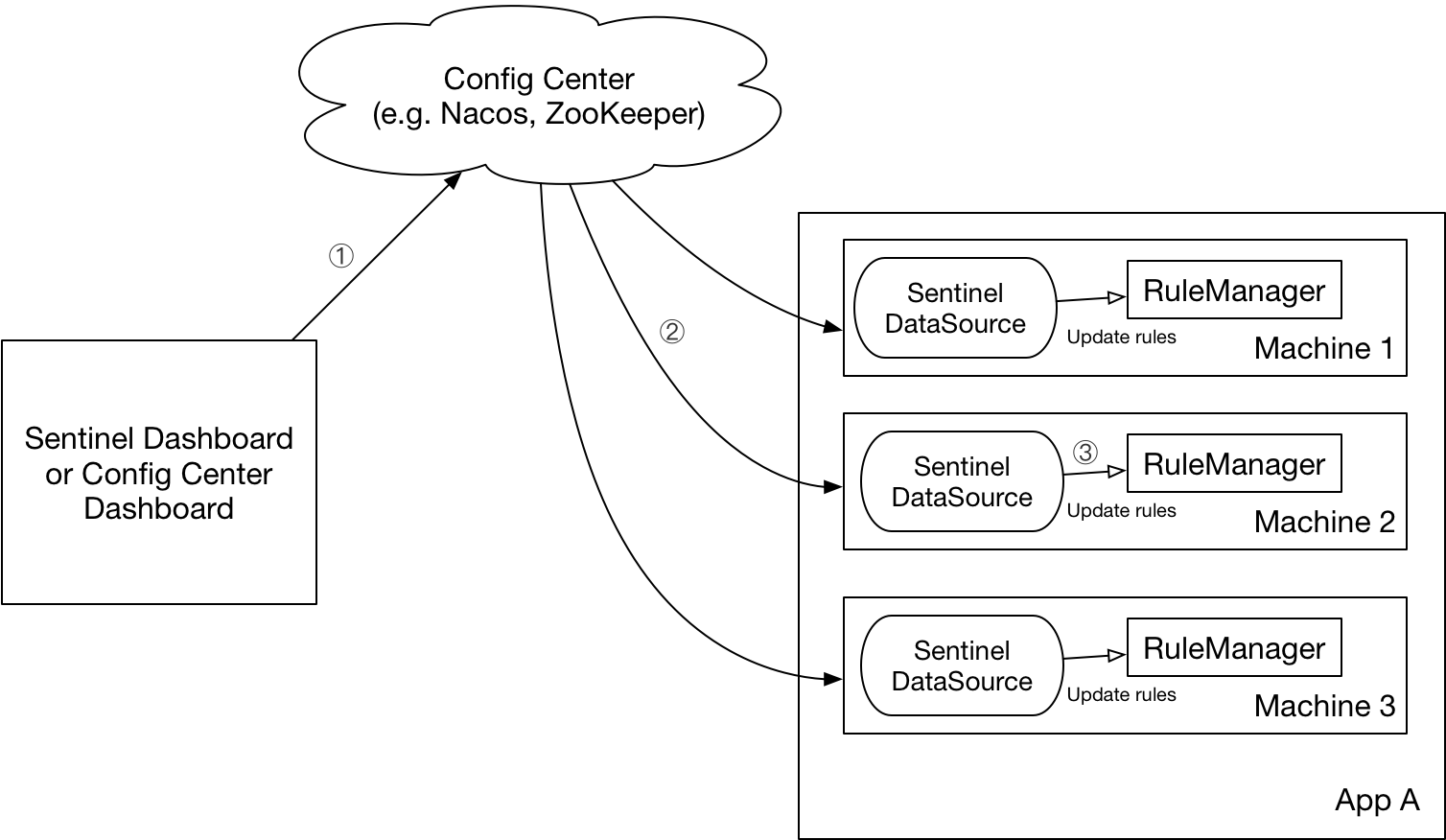- 1【模型压缩】(四)——知识蒸馏_def get_mean_and_std(dataset): ''' 可以设计函数获取数据的均值和方
- 2Macbook pro m2适配2k显示器_macbookpro m2和2k显示器
- 3Transmission 3.0-19 如何升级WebUI套件(群晖NAS升级DSM7.0以后)_transmission 3 套件
- 4Jupyter notebook添加与删除kernel_jupyter添加内核
- 5【数据结构与算法】时间复杂度和空间复杂度_空间复杂度和时间复杂度的关系
- 6gitee创建仓库并创建分支_gitee创建分支
- 7Python中使用`replace`函数进行字符串替换操作是一种常见的技巧。本文将详细介绍如何使用`replace`函数来修改字符串,并提供相应的源代码示例。_python replace 通配符
- 8跳槽了,字节测试岗3轮面试,4个小时灵魂拷问,结局透心凉..._字节面试一般几轮
- 9程序员如何打破需求魔咒:为什么人越招越多,活越干越累?_小红书 风笛
- 10【机器学习】异常检测算法速览(Python代码)
Sentinel 动态规则扩展_动态扩展
赞
踩
一、规则
Sentinel 的理念是开发者只需要关注资源的定义,当资源定义成功后可以动态增加各种流控降级规则。Sentinel 提供两种方式修改规则:
- 通过 API 直接修改 (loadRules)
- 通过 DataSource 适配不同数据源修改
手动通过 API 修改比较直观,可以通过以下几个 API 修改不同的规则:
- FlowRuleManager.loadRules(List<FlowRule> rules); // 修改流控规则
- DegradeRuleManager.loadRules(List<DegradeRule> rules); // 修改降级规则
手动修改规则(硬编码方式)一般仅用于测试和演示,生产上一般通过动态规则源的方式来动态管理规则。
二、DataSource 扩展
上述 loadRules() 方法只接受内存态的规则对象,但更多时候规则存储在文件、数据库或者配置中心当中。DataSource 接口给我们提供了对接任意配置源的能力。相比直接通过 API 修改规则,实现 DataSource 接口是更加可靠的做法。
我们推荐通过控制台设置规则后将规则推送到统一的规则中心,客户端实现 ReadableDataSource 接口端监听规则中心实时获取变更,流程如下:

DataSource 扩展常见的实现方式有:
- 拉模式:客户端主动向某个规则管理中心定期轮询拉取规则,这个规则中心可以是 RDBMS、文件,甚至是 VCS 等。这样做的方式是简单,缺点是无法及时获取变更;
- 推模式:规则中心统一推送,客户端通过注册监听器的方式时刻监听变化,比如使用 Nacos、Zookeeper 等配置中心。这种方式有更好的实时性和一致性保证。
Sentinel 目前支持以下数据源扩展:
- Pull-based: 动态文件数据源、Consul, Eureka
- Push-based: ZooKeeper, Redis, Nacos, Apollo, etcd
三、拉模式拓展
实现拉模式的数据源最简单的方式是继承 AutoRefreshDataSource 抽象类,然后实现 readSource() 方法,在该方法里从指定数据源读取字符串格式的配置数据。比如 基于文件的数据源。
四、推模式拓展
实现推模式的数据源最简单的方式是继承 AbstractDataSource 抽象类,在其构造方法中添加监听器,并实现 readSource() 从指定数据源读取字符串格式的配置数据。比如 基于 Nacos 的数据源。
控制台通常需要做一些改造来直接推送应用维度的规则到配置中心。功能示例可以参考 AHAS Sentinel 控制台的规则推送功能。改造指南可以参考 在生产环境中使用 Sentinel 控制台。
五、注册数据源
通常需要调用以下方法将数据源注册至指定的规则管理器中:
- ReadableDataSource<String, List<FlowRule>> flowRuleDataSource = new NacosDataSource<>(remoteAddress, groupId, dataId, parser);
- FlowRuleManager.register2Property(flowRuleDataSource.getProperty());
若不希望手动注册数据源,可以借助 Sentinel 的 InitFunc SPI 扩展接口。只需要实现自己的 InitFunc 接口,在 init 方法中编写注册数据源的逻辑。比如:
- package com.test.init;
-
- public class DataSourceInitFunc implements InitFunc {
-
- @Override
- public void init() throws Exception {
- final String remoteAddress = "localhost";
- final String groupId = "Sentinel:Demo";
- final String dataId = "com.alibaba.csp.sentinel.demo.flow.rule";
-
- ReadableDataSource<String, List<FlowRule>> flowRuleDataSource = new NacosDataSource<>(remoteAddress, groupId, dataId,
- source -> JSON.parseObject(source, new TypeReference<List<FlowRule>>() {}));
- FlowRuleManager.register2Property(flowRuleDataSource.getProperty());
- }
- }
接着将对应的类名添加到位于资源目录(通常是 resource 目录)下的 META-INF/services 目录下的 com.alibaba.csp.sentinel.init.InitFunc 文件中,比如:
com.test.init.DataSourceInitFunc
这样,当初次访问任意资源的时候,Sentinel 就可以自动去注册对应的数据源了。
六、示例
1、API 模式:使用客户端规则 API 配置规则
Sentinel Dashboard 通过客户端自带的规则 API来实时查询和更改内存中的规则。
注意: 要使客户端具备规则 API,需在客户端引入以下依赖:
- <dependency>
- <groupId>com.alibaba.csp</groupId>
- <artifactId>sentinel-transport-simple-http</artifactId>
- <version>x.y.z</version>
- </dependency>
2、拉模式:使用文件配置规则
这个示例展示 Sentinel 是如何从文件获取规则信息的。FileRefreshableDataSource 会周期性的读取文件以获取规则,当文件有更新时会及时发现,并将规则更新到内存中。使用时只需添加以下依赖:
- <dependency>
- <groupId>com.alibaba.csp</groupId>
- <artifactId>sentinel-datasource-extension</artifactId>
- <version>x.y.z</version>
- </dependency>
3、推模式:使用 Nacos 配置规则
Nacos 是阿里中间件团队开源的服务发现和动态配置中心。Sentinel 针对 Nacos 作了适配,底层可以采用 Nacos 作为规则配置数据源。使用时只需添加以下依赖:
- <dependency>
- <groupId>com.alibaba.csp</groupId>
- <artifactId>sentinel-datasource-nacos</artifactId>
- <version>x.y.z</version>
- </dependency>
然后创建 NacosDataSource 并将其注册至对应的 RuleManager 上即可。比如:
- // remoteAddress 代表 Nacos 服务端的地址
- // groupId 和 dataId 对应 Nacos 中相应配置
- ReadableDataSource<String, List<FlowRule>> flowRuleDataSource = new NacosDataSource<>(remoteAddress, groupId, dataId,
- source -> JSON.parseObject(source, new TypeReference<List<FlowRule>>() {}));
- FlowRuleManager.register2Property(flowRuleDataSource.getProperty());
注意:如果希望初始化 Nacos 数据源时携带更多的配置(如鉴权配置),可通过带 Properties 的构造函数进行传入。
详细示例可以参见 sentinel-demo-nacos-datasource。
4、推模式:使用 ZooKeeper 配置规则
Sentinel 针对 ZooKeeper 作了相应适配,底层可以采用 ZooKeeper 作为规则配置数据源。使用时只需添加以下依赖:
- <dependency>
- <groupId>com.alibaba.csp</groupId>
- <artifactId>sentinel-datasource-zookeeper</artifactId>
- <version>x.y.z</version>
- </dependency>
然后创建 ZookeeperDataSource 并将其注册至对应的 RuleManager 上即可。比如:
- // remoteAddress 代表 ZooKeeper 服务端的地址
- // path 对应 ZK 中的数据路径
- ReadableDataSource<String, List<FlowRule>> flowRuleDataSource = new ZookeeperDataSource<>(remoteAddress, path, source -> JSON.parseObject(source, new TypeReference<List<FlowRule>>() {}));
- FlowRuleManager.register2Property(flowRuleDataSource.getProperty());
详细示例可以参见 sentinel-demo-zookeeper-datasource。
5、推模式:使用 Apollo 配置规则
Sentinel 针对 Apollo 作了相应适配,底层可以采用 Apollo 作为规则配置数据源。使用时只需添加以下依赖:
- <dependency>
- <groupId>com.alibaba.csp</groupId>
- <artifactId>sentinel-datasource-apollo</artifactId>
- <version>x.y.z</version>
- </dependency>
然后创建 ApolloDataSource 并将其注册至对应的 RuleManager 上即可。比如:
- // namespaceName 对应 Apollo 的命名空间名称
- // ruleKey 对应规则存储的 key
- // defaultRules 对应连接不上 Apollo 时的默认规则
- ReadableDataSource<String, List<FlowRule>> flowRuleDataSource = new ApolloDataSource<>(namespaceName, ruleKey, defaultRules, source -> JSON.parseObject(source, new TypeReference<List<FlowRule>>() {}));
- FlowRuleManager.register2Property(flowRuleDataSource.getProperty());
详细示例可以参见 sentinel-demo-apollo-datasource。
6、推模式:使用 Redis 配置规则
Sentinel 针对 Redis 作了相应适配,底层可以采用 Redis 作为规则配置数据源。使用时只需添加以下依赖:
- <!-- 仅支持 JDK 1.8+ -->
- <dependency>
- <groupId>com.alibaba.csp</groupId>
- <artifactId>sentinel-datasource-redis</artifactId>
- <version>x.y.z</version>
- </dependency>



